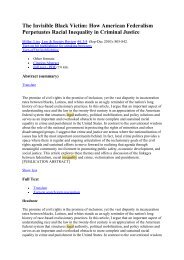Ski – resort and regional development: profile of visitors ... - E-Journal
Ski – resort and regional development: profile of visitors ... - E-Journal
Ski – resort and regional development: profile of visitors ... - E-Journal
You also want an ePaper? Increase the reach of your titles
YUMPU automatically turns print PDFs into web optimized ePapers that Google loves.
114<br />
Garyfallos Arabatzis, Serafeim Polyzos <strong>and</strong> Stavros Tsiantikoudis<br />
existence <strong>of</strong> forests, (d) the existence <strong>of</strong> torrents <strong>and</strong> streams <strong>and</strong> riverside ecosystems <strong>and</strong><br />
(e) the existence <strong>of</strong> Alpine grassl<strong>and</strong>s that form the habitat <strong>of</strong> flora <strong>and</strong> fauna species.<br />
The good condition <strong>of</strong> the <strong>regional</strong> natural environment derives from the maintenance <strong>of</strong><br />
traditional l<strong>and</strong> uses which remained extensional. This has a negative effect on the economic<br />
<strong>development</strong> <strong>of</strong> the area but allows the maintenance <strong>of</strong> a high quality natural environment<br />
<strong>and</strong> consequently <strong>of</strong> sustainable tourism <strong>development</strong>. From a "traditional" point <strong>of</strong> view, the<br />
area <strong>of</strong>fers very limited possibilities <strong>of</strong> <strong>development</strong>. From a "modern" point <strong>of</strong> view its<br />
prospects are particularly good, once the sustainable <strong>development</strong> that will be supported by<br />
activities <strong>of</strong> a mild form is possible. This <strong>development</strong> would not be a burden to the natural<br />
environment which in combination with the anthropogenic environment would maintain the<br />
tourist attractiveness <strong>of</strong> the area <strong>and</strong> would create a combined product with an increased added<br />
value on a local level. Moreover, it would achieve the increase <strong>of</strong> employment in the area <strong>and</strong><br />
the maintenance <strong>of</strong> the economically active population, which would possibly be occupied<br />
in the service sector but also additionally in the primary sector.<br />
The human activities in the area are limited because <strong>of</strong> the decreased human potential, but<br />
also because <strong>of</strong> the low rate <strong>of</strong> <strong>development</strong>, so that the impact on the environment is little.<br />
Regarding the tourist activities, particular attention should be paid to the sizes that can be<br />
developed without being a burden to the environment. This concerns the size <strong>of</strong> tourism<br />
facilities as well as the number <strong>of</strong> <strong>visitors</strong> to the important biotopes.<br />
The natural <strong>and</strong> social characteristics <strong>of</strong> the study area do not encourage particularly the<br />
<strong>development</strong> <strong>of</strong> tourist activities in the models <strong>of</strong> mass tourism. On the contrary, the area is<br />
in a comparatively better position regarding the <strong>development</strong> <strong>of</strong> "alternative" forms <strong>of</strong> tourism,<br />
supported mainly by elements as the natural <strong>and</strong> cultural environment, the traditional way <strong>of</strong><br />
life, the contact with nature, underst<strong>and</strong>ing the cultural <strong>and</strong> historical features <strong>of</strong> the tourism<br />
destinations. It allocates those elements that will support activities like the naturalist tourism,<br />
the sport tourism, the tourism <strong>of</strong> adventure, the cultural tourism <strong>and</strong> the ecotourism.<br />
The most important differentiation <strong>of</strong> this tourism model compared to the previous perceptions<br />
are the respect for the local environment (natural, cultural, social) which becomes a vital<br />
advantage <strong>of</strong> the destination area <strong>and</strong> the visitor’s experience who becomes more dem<strong>and</strong>ing<br />
as the quality <strong>of</strong> the provided services is concerned, especially when it comes to the point <strong>of</strong><br />
information. From this point <strong>of</strong> view, planning <strong>of</strong> infrastructure <strong>and</strong> activities that are related<br />
to the tourism <strong>development</strong> in the study area should be made according to specific st<strong>and</strong>ards<br />
that will minimise the consequences for the natural <strong>and</strong> anthropogenic environment.<br />
METHODOLOGY OF ESTIMATION OF CARRYING CAPACITY OF<br />
MOUNTAINOUS TOURIST AREAS<br />
The term <strong>of</strong> carrying capacity should not be treated as an absolute size, but should be examined<br />
in regard to social, cultural <strong>and</strong> economic conditions. In the planning <strong>of</strong> tourism <strong>development</strong><br />
Tourism Today - Fall 2007 - Full Paper














